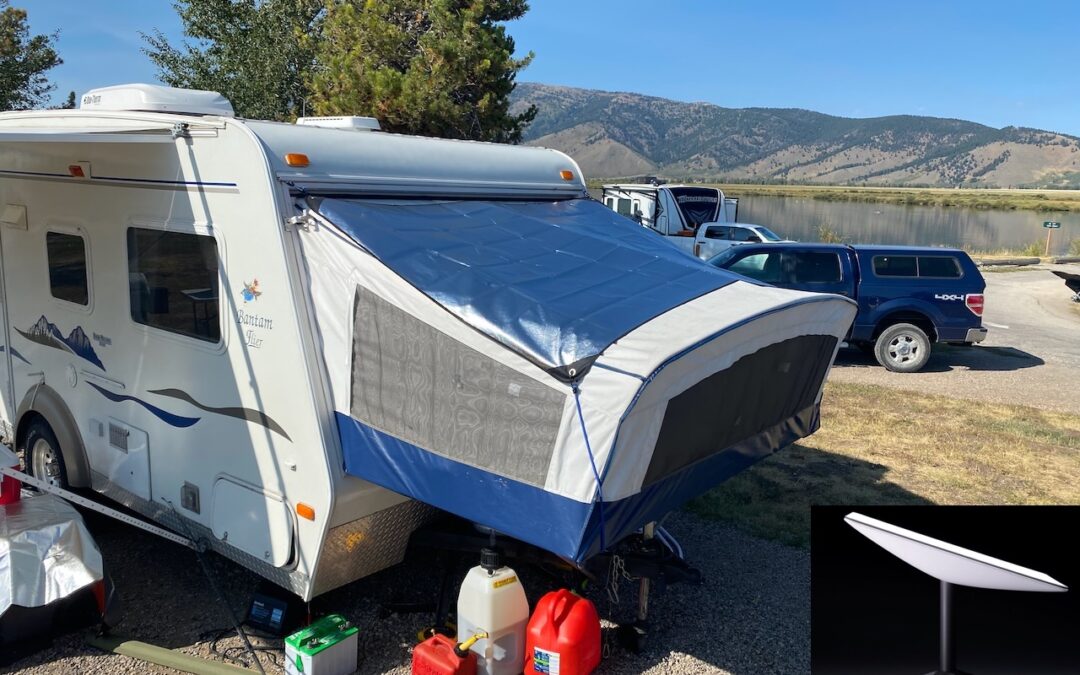Just about a week ago, our prior post described the latest updates from Starlink including current network status, coverage, and the new portability feature. The newly announced Starlink for RVs expands on portability with some additional flexibility.
A Bit of Background
The standard Starlink terminal unit currently that is currently being sold, (as well as the 2 prior versions) is designed for stationary use, placed on the ground, or mounted to a house like a satellite TV dish. While it also seems to work in-motion to some degree, it’s not designed to be mounted to a moving vehicle or vessel, and Starlink themselves continue to state that “In-motion” is not supported or allowed.
In addition, the service plan for Starlink is clearly targeted at residential users looking for a broadband Internet service. The service plan is an ongoing, flat fee, monthly subscription, and registered to your home address. In order to take the unit to an alternate address, such as a vacation home or camp site, you must enable portability for an extra fee ($25/mo extra in the US).
Portability (formerly unofficially called roaming) helps out boaters by giving them the ability to move the unit around to different anchorages away from their home and using the connection for high-speed Internet. But, while you can disable portability (and hence drop the extra fee) once you’ve returned the unit to the registered address, completely cancelling the base service is discouraged. There’s no guarantee that you can re-activate the system, particularly if your registered address is in an area that is waitlisted currently. Basically, you’d be put at the back of the list and have to wait to re-enable service.
Enter “Starlink for RVs”
This new plan uses the same hardware as the residential service, so all of the existing limitations apply–the terminal is not designed for in-motion use, not fully waterproof, same size, AC powered, etc. But the service plan itself provides some new benefits while sacrificing some performance.
Comparison Table
Plan | Starlink Residential Service | Starlink for RVs |
| Monthly Price | $110/month | $135/mo |
| Suspend/Resume | No | Yes |
| Portability | $25/mo extra | Included |
| Std Pri in Active Cells | High | Low |
| Std Pri in Waitlist Cells | High | Low |
| Roaming Pri In Active | High | Low |
| Roaming Pri in Waitlist | Low | Low |
| High Speed Internet | Yes | Yes |
| Use in another country | Max 2 Months | Max 2 Months |
| Use on another Continent | No | No |
| Order to Active Cells | Yes | Yes |
| Order to Waitlist Cells | No | Yes |
Basically, no matter whether your address is active or waitlisted, you can get an RV unit now. But RV units get “best-effort” service, meaning they are lower priority than other terminals. If there’s congestion in the network where you are using your unit, your performance can and will suffer. On the upside, you can suspend and resume service when needed, without being put into a waitlist when you reactivate. And you can take it anywhere Starlink has service on your home continent (limited to a maximum of 2 months outside your home country).
How does this affect boats?
- Well, the hardware is the same, so the same installation requirements/limitations/challenges apply as with the standard service including the need for AC power (inverter, generator, shore power)
- If you are a boater in a waitlisted area, currently unable to order a unit, switching to an RV order will get you the unit right away.
- While travelling, an RV unit will connect anywhere there is service, but will always be de-prioritized vs. residential units in the same area. So, performance will be highly variable and possibly poor at times.
- If your use is seasonal, the RV plan may be better because you can suspend and resume service without worrying about waitlists.
What does de-prioritize really mean?
Prioritization is a term that simply means giving priority to some users over other users in some way. For networks, many wireless and satellite Internet providers use prioritization to create limits for “unlimited” data plans. In those cases, once you’ve used some amount of data in a given month (50GB for example) your usage is “deprioritized”. This is different from “throttling”. When throttled, your network speed is limited to a specific lower speed–600kbps, 2G, 3G, etc. But when deprioritized, there’s no specific speed limit. Your data is just put in line behind everyone else’s. So if the network is very busy and all users are experiencing some slowness, you will experience EVEN MORE slowness because the network puts your data behind everyone else’s in the line. The result is highly variable performance. Some days and locations will be excellent. Other days or locations can be horrible.
Sea-Tech Systems has our own residential Starlink unit and has done a lot of testing over the past 19 months. We’ve also ordered an RV unit which is expected to arrive in a week or so. And since our home office cell is also in a waitlisted area we will do some performance testing between a residential unit and an RV unit in waitlisted and non-waitlisted areas, as well as travelling with both units into remote areas. We’ll post the results once we have them.
Want to Learn More about Offshore Comms? Subscribe to Marine Electronics Advisor today and get started!
Are you looking for turn-key Wi-Fi, Cellular, and Satellite solution with Starlink for your boat? Check out Sea-Tech’s Narwhal for Starlink systems for fully integrated wi-fi, cellular, and satellite communications systems. Fully compatible with Starlink and any other satellite internet service as well.

